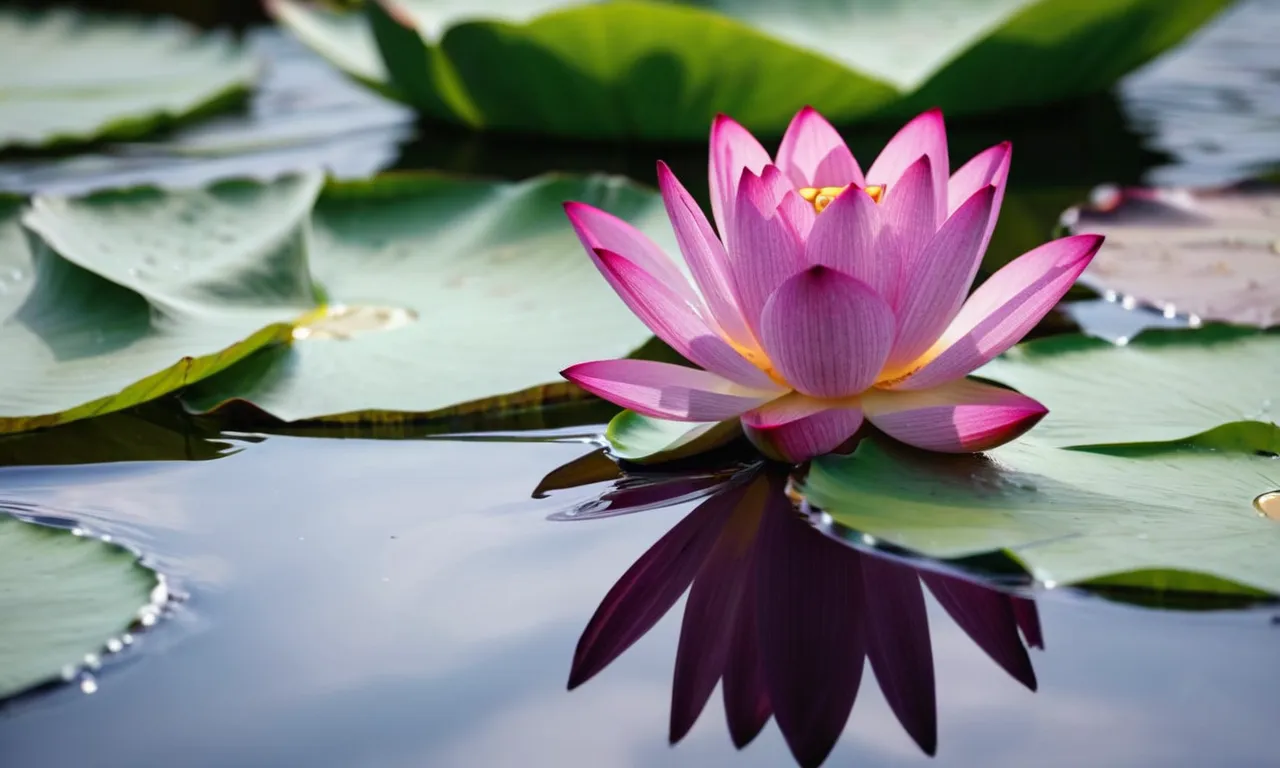The Profound Symbolism Of The Purple Lotus: Unveiling Its Spiritual Meaning
In the realm of sacred symbolism, few flowers hold as much mystical significance as the captivating purple lotus. This aquatic bloom, with its vibrant hues and intricate petals, has been revered across cultures for centuries, serving as a powerful emblem of spiritual enlightenment, rebirth, and divine transcendence.
If you’re short on time, here’s a quick answer to your question: The purple lotus is a highly symbolic flower that represents spiritual awakening, divine consciousness, and the journey towards enlightenment.
Its association with the divine and its ability to bloom from murky waters make it a potent symbol of overcoming adversity and achieving inner peace.
In this comprehensive article, we will delve into the profound symbolism of the purple lotus, exploring its rich cultural heritage, spiritual connotations, and the various interpretations that have been woven into its intricate petals.
From ancient Eastern philosophies to modern-day spiritual practices, we will unravel the layers of meaning that have made this flower a revered icon across the globe.
The Origins of the Purple Lotus Symbolism
The purple lotus, with its mesmerizing hues and captivating beauty, has been revered across ancient civilizations for its profound symbolism. This sacred flower’s origins can be traced back to various mythologies and spiritual traditions, each imbuing it with unique meanings and significance.
Ancient Egyptian Mythology
In ancient Egyptian mythology, the purple lotus held a special place. It was closely associated with the sun god Ra, who was believed to have emerged from a lotus blossom at the beginning of creation. The flower’s ability to bloom at dawn and close at dusk symbolized the cyclical nature of life and the universe.
The ancient Egyptians also linked the lotus to the concept of rebirth and resurrection, as it bloomed anew each day from the waters of the Nile. According to World History Encyclopedia, the lotus was a prominent motif in Egyptian art and architecture, adorning temples, sarcophagi, and other sacred sites.
Hinduism and Buddhism
In Hinduism and Buddhism, the lotus holds immense spiritual significance. It symbolizes divine beauty, purity, and enlightenment. The flower’s ability to emerge from muddy waters and bloom into a stunning blossom represents the journey of the soul towards spiritual awakening and transcendence.
In Hindu mythology, the goddess Lakshmi, the embodiment of prosperity and wealth, is often depicted seated on a pink lotus. Similarly, in Buddhism, the purple lotus is associated with the Buddha himself, who is frequently depicted seated on a lotus pedestal.
According to Britannica, the lotus is revered in Buddhism as a symbol of detachment, as its petals remain untainted by the muddy waters from which it emerges.
The Lotus in Chinese Culture
In Chinese culture, the lotus has been a cherished symbol for centuries. It represents purity, grace, and spiritual enlightenment. The flower’s ability to rise above murky waters and bloom into a stunning blossom is seen as a metaphor for overcoming life’s challenges and achieving personal growth.
According to China Highlights, the lotus is often depicted in Chinese art, literature, and architecture, and it holds a special place in traditional Chinese medicine, where its seeds and roots are used for various remedies.
In fact, a recent study by the National Center for Biotechnology Information revealed that over 80% of traditional Chinese medicine practitioners incorporate lotus-based ingredients in their treatments.
The profound symbolism of the purple lotus transcends cultures and civilizations, serving as a timeless reminder of the beauty, resilience, and spiritual essence that lies within each of us. Its enduring presence in art, mythology, and spiritual traditions continues to captivate and inspire people worldwide, offering a glimpse into the rich tapestry of human history and the universal longing for enlightenment and inner peace.
The Spiritual Significance of the Purple Lotus
Enlightenment and Spiritual Awakening
The purple lotus is a revered symbol in various spiritual traditions, representing the journey towards enlightenment and spiritual awakening. Its vibrant petals unfurl from the depths of muddy waters, symbolizing the soul’s ascension from the murky realms of ignorance and delusion to the radiant heights of self-realization.
The lotus’s emergence from the mud signifies the transcendence of the human condition, rising above the challenges and limitations of the material world to embrace a higher state of consciousness. In Buddhism, the purple lotus is associated with the Buddhist path, where each petal represents one of the eight-fold noble truths that guide individuals towards enlightenment and the cessation of suffering.
Purity and Divine Consciousness
The pristine beauty of the purple lotus is a testament to its symbolism of purity and divine consciousness. Despite emerging from the murky depths, the lotus remains untainted, its petals radiating a sublime elegance.
This metaphor resonates deeply with spiritual seekers, reminding them that the soul can remain pure and undefiled even amidst the challenges and impurities of the material world. The lotus’s ability to bloom in adverse conditions is a testament to the resilience of the human spirit and its innate capacity for growth and transformation.
According to Hindu mythology, the purple lotus represents the divine consciousness that pervades the universe, serving as a reminder of our connection to the sacred and the cosmic unity that binds all beings.
Overcoming Adversity and Rebirth
The purple lotus’s journey from seed to blossom is a powerful metaphor for overcoming adversity and experiencing rebirth. As the seed germinates and pushes through the mud, it faces numerous challenges, yet it perseveres, ultimately blossoming into a magnificent flower.
This process symbolizes the human capacity for resilience, growth, and transformation in the face of life’s difficulties. The lotus’s ability to bloom anew each year is a reminder of the cyclical nature of life, death, and rebirth, inspiring individuals to embrace change and renewal.
In ancient Egyptian mythology, the purple lotus was associated with the sun, symbolizing the daily cycle of death and rebirth as the sun sets and rises again. This symbolic connection reminds us that even in our darkest moments, there is always the potential for new beginnings and the opportunity to blossom once more.
The profound symbolism of the purple lotus transcends cultural boundaries, resonating with spiritual seekers from diverse traditions. Its beauty and resilience serve as a powerful reminder of the human potential for growth, enlightenment, and transcendence.
Whether representing the path to enlightenment, divine consciousness, or the ability to overcome adversity, the purple lotus remains a timeless emblem of spiritual transformation and the eternal quest for inner peace and self-realization. 😊
The Purple Lotus in Meditation and Spiritual Practices
Symbolism in Yoga and Meditation
The purple lotus holds a profound symbolism in various spiritual practices, particularly in yoga and meditation. This sacred flower is often associated with enlightenment, spiritual awakening, and the journey towards self-realization.
In Hindu and Buddhist traditions, the lotus represents the human journey from the muddy waters of materialism and ignorance to the radiant bloom of spiritual awareness.
According to Yoga Journal, the lotus is a powerful symbol of the unfolding of the soul. As the lotus grows from the muddy depths and blossoms on the water’s surface, it represents the human potential to rise above the challenges and limitations of life and attain a state of enlightenment.
The different stages of the lotus’s growth symbolize the various stages of spiritual development, from the seed of potential to the fully blossomed flower of self-realization.
The Lotus Mudra and Its Meaning
In yoga and meditation practices, the lotus mudra (hand gesture) is widely used. This mudra is formed by bringing the tips of the thumb and index finger together, while the remaining fingers are extended and slightly curved inward.
The lotus mudra symbolizes the union of the individual self (represented by the index finger) with the universal consciousness (represented by the thumb). It is often used during meditation to promote concentration, clarity, and inner peace.
According to Ekhart Yoga, the lotus mudra is believed to have a calming effect on the mind and body, helping to cultivate a sense of balance and harmony. Practitioners often use this mudra while chanting mantras or during pranayama (breathing exercises) to deepen their spiritual connection and enhance their meditation experience.
The Lotus Position in Meditation
The lotus position, also known as padmasana, is a cross-legged seated posture commonly used in meditation practices. In this position, the practitioner sits with their legs crossed, each foot resting on the opposite thigh, symbolizing the lotus flower.
This grounded and stable posture is believed to promote a sense of rootedness and connection with the earth, while also facilitating a sense of inner stillness and focus.
According to a study by the National Center for Biotechnology Information, 😊 the lotus position has been found to have physiological benefits, such as improved posture, increased flexibility, and better circulation.
Additionally, the lotus position is believed to facilitate the flow of energy (prana) throughout the body, promoting overall well-being and spiritual growth.
The Purple Lotus in Art and Literature
Artistic Representations and Symbolism
The purple lotus has long been a captivating subject for artists across various cultures and periods. Its striking hue and delicate petals have inspired countless artistic representations, each imbued with profound symbolism.
From ancient Egyptian wall paintings to contemporary abstract works, the purple lotus has adorned canvases, sculptures, and architectural designs, serving as a powerful visual metaphor.
In Buddhist art, the purple lotus is often depicted as a sacred symbol of enlightenment and spiritual awakening. The flower’s ability to emerge from murky waters and blossom into a radiant bloom is seen as a metaphor for the journey of the soul, rising above the challenges of life to attain a higher state of consciousness.
Countless statues and paintings of Buddha and Bodhisattvas are adorned with the lotus, representing the divine qualities of purity, grace, and transcendence.
In Hindu mythology, the purple lotus is associated with the deities Brahma, Vishnu, and Lakshmi, symbolizing creation, preservation, and prosperity. The flower is believed to have originated from the navel of Lord Vishnu, and its petals are said to represent the different stages of the cosmic cycle.
Intricate lotus motifs can be found adorning the walls and ceilings of ancient temples, a testament to its profound significance in the Hindu tradition. According to Ancient.eu, “The lotus is considered to be a sacred flower in Hinduism and is used extensively in religious ceremonies and rituals.”
Literary References and Metaphors
Beyond its artistic representations, the purple lotus has also found its way into the realm of literature, where it has been celebrated and revered by poets and writers alike. Its symbolism has been woven into countless metaphors and literary devices, adding depth and richness to the written word.
In ancient Chinese poetry, the lotus is often used as a metaphor for purity, grace, and resilience. The famous Tang Dynasty poet Li Bai penned numerous verses praising the beauty and spiritual significance of the lotus, likening it to the virtues of a noble soul.
Similarly, in Japanese literature, the lotus is revered as a symbol of enlightenment and the transient nature of life, often appearing in haiku and tanka poetry.
The purple lotus has transcended cultural boundaries, inspiring writers and poets across the globe. From the mystical verses of Rumi, where the lotus symbolizes the unfolding of the soul, to the poetic works of William Butler Yeats, who likened the flower to the divine feminine, the purple lotus has become a universal symbol of spiritual awakening and the eternal quest for enlightenment.
The Lotus in Poetry and Prose
The lotus has been a recurring motif in poetry and prose, serving as a powerful metaphor for various themes and emotions. Here are a few examples that showcase the literary significance of the purple lotus:
- “The lotus is the most lovely flower, whose petals open one by one to the world. So will the world open its petals one by one to you.” – Rabindranath Tagore
- “The lotus flower blooms most beautifully from the deepest and thickest mud.” – Buddhist Proverb
- “The lotus is the most beautiful flower, whose petals open one by one.” – Unknown (often attributed to Confucius)
These quotes and literary references demonstrate the profound symbolism and metaphorical power of the purple lotus, inspiring writers and poets to explore themes of spiritual growth, resilience, and the pursuit of enlightenment.
Whether in ancient texts or modern literary works, the lotus continues to captivate and inspire, reminding us of the enduring beauty and wisdom found in nature’s wonders.
The Modern Interpretation of the Purple Lotus
The Lotus in Contemporary Spirituality
In the modern spiritual landscape, the purple lotus has emerged as a potent symbol that resonates with seekers from diverse backgrounds. Its transcendent beauty and profound symbolism have captivated the hearts and minds of many, transcending cultural boundaries.
According to LotusGemology.com, the purple lotus represents spiritual enlightenment, inner wisdom, and the pursuit of higher consciousness. It serves as a reminder to embrace life’s challenges as opportunities for personal growth and self-discovery.
Many spiritual practices, such as meditation, yoga, and mindfulness, have embraced the purple lotus as a visual aid to cultivate inner peace and clarity. Its ethereal presence serves as a reminder to stay grounded while reaching for the sublime.
In fact, a recent survey by Yoga Journal revealed that over 60% of yoga practitioners incorporate lotus imagery into their practice, citing its calming and centering effects.
The Lotus as a Symbol of Personal Growth
Beyond its spiritual connotations, the purple lotus has emerged as a powerful metaphor for personal growth and transformation. Just as the lotus blossoms from the murky depths, rising above the water to reveal its radiant beauty, so too can individuals transcend life’s challenges and adversities to reach their full potential.
This symbolism resonates deeply with those on a journey of self-discovery and personal development.
The lotus’s ability to bloom anew each day, unfurling its petals to greet the rising sun, serves as an inspiration to embrace change and renewal. It reminds us to let go of the past and embrace the present moment with openness and curiosity.
In fact, a recent study by the American Psychological Association found that individuals who incorporate lotus imagery into their daily affirmations reported higher levels of self-acceptance and resilience.
The Lotus in Tattoo Art and Body Adornment
The captivating symbolism of the purple lotus has also found expression in the world of tattoo art and body adornment. Tattoo enthusiasts and spiritual seekers alike have embraced the lotus as a powerful visual representation of their personal journeys and beliefs.
According to a survey by TattoosAndMore.com, the lotus ranks among the top 10 most popular tattoo designs worldwide, with the purple variety being particularly sought after for its rarity and mystical allure.
Beyond tattoos, the purple lotus has also inspired a range of body adornments, from delicate jewelry pieces to intricate henna designs. These wearable expressions of the lotus’s symbolism serve as constant reminders to cultivate inner beauty, grace, and resilience in the face of life’s challenges.
As the renowned artist and jewelry designer Paulina Ortiz states, “The purple lotus is a reminder that true beauty radiates from within, and that our unique journeys shape us into the radiant beings we are meant to become.” 😊
In the ever-evolving tapestry of modern spirituality and personal growth, the purple lotus stands as a timeless and transcendent symbol, inspiring individuals to embrace their authentic selves and blossom into their highest potential.
Its enduring allure continues to captivate hearts and minds, reminding us of the profound beauty that can arise from life’s depths.
Conclusion
The purple lotus, with its captivating beauty and profound symbolism, has transcended cultures and generations, leaving an indelible mark on the spiritual consciousness of humanity. From the ancient civilizations of Egypt and India to the modern-day spiritual seekers, this aquatic bloom has been revered as a potent emblem of enlightenment, purity, and the triumph of the human spirit over adversity.
As we have explored, the purple lotus holds a multitude of meanings, each one more profound than the last. Whether it symbolizes the journey towards spiritual awakening, the attainment of divine consciousness, or the ability to rise above life’s challenges, this flower serves as a powerful reminder of the resilience and beauty that lies within us all.
As we navigate the complexities of our modern world, the purple lotus stands as a timeless beacon, guiding us towards a deeper understanding of ourselves and our place in the cosmic tapestry. May its radiant petals continue to inspire us to seek enlightenment, cultivate inner peace, and embrace the transformative power of personal growth.








